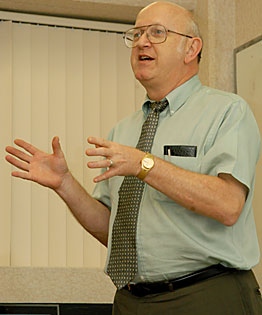 |
|
SAUL LOEB/Arizona Daily Wildcat
|
Chemistry professor Michael P. Doyle speaks about the various options available to students after graduation in the biomedical field yesterday afternoon in the Physics and Atmospheric Sciences building.
|
|
By Brittany Manson
Arizona Daily Wildcat
Thursday October 17, 2002
A College of Science master's program meshing business and science for a tailor-made degree specially designed for the needs of the scientific industry graduated its ninth student last semester.
The Professional Master's Degree program was developed in response to industry leaders' interest in hiring highly educated students who understand the connection between science and business, said Alaina Levine, director of special projects for the College of Science.
The program, which currently has 26 students and 9 graduates, allows students to choose from three tracks: applied and industrial physics, applied biosciences and mathematical sciences.
Each track consists of five parts: core science courses, business courses, lectures from industry professionals, internships and final projects.
The business courses include foundations of business for scientists, which covers marketing, accounting and business ethics, among others, and project management, which includes processes and applications geared toward the science and industry sector.
The colloquia feature professionals from organizations and businesses like the Los Alamos National Laboratory, Intel Corporation and IBM. Leaders from different companies also visit mixers to recruit students and tell them about the career options available to them.
At-a-glance:
· Students in the Professional Master's Degree program take courses in science and business, do internships or master's projects and hear talks from leaders and recruiters at national corporations as part of their program.
· The program was developed in response to industry leaders' interest in hiring graduates who have both science and business experience.
· Since the program started in 2000, 9 students have graduated. Twenty-six students are in the program this year.
· Any student, staff or faculty member is invited to sit in on weekly talks with industry leaders.
For more information, call Alaina Levine at 621-3374.
|
The program helps its graduates obtain jobs in various fields like consulting, commerce, patent and regulatory affairs, research management and technology transfer, which is how a idea or innovation goes from an individual, company or university to the public, said Levine.
She explained this program is a professional program, which carries the credibility and reputation as a doctorate program.
The Sloan Foundation funded the program through a national initiative in 1997. Alfred Pritchard Sloan, Jr., then president and CEO of General Motors, established the foundation in 1934.
Students choose between doing a master's thesis and a report based on their internship experience as a final project.
Levine describes the program and the idea of combining science and business as a "revolutionary approach to graduate students in sciences."
"It's a big selling point," said Michelle Kidd, a student in the program with an emphasis on applied mathematics.
She learned about the program after being recruited by the UA doctorate program. She had already earned her bachelor's degree from the University of Pittsburgh, and was planning to continue on for a doctorate, but she switched to the professional master's degree program.
"It's the total package," she said, adding that it makes a graduate from the program "stand out much more."
Companies would usually hire either MBA graduates and teach them the scientific aspects of the job or teach science graduate the business aspect. This way, a graduate with both science and business has an advantage, Kidd said.
"It gives a more inside look to industry," said Nicola Burgess, a student in the applied and industrial physics track.
Burgess learned of the program through her physics professor, Mike Shupe, and Levine.
Michael Doyle, a chemistry professor, gave a presentation at last night's colloquium on careers available to the students.
He explained that in the 1960s, when he started his career, if people got a master's degree it was only because they couldn't get a doctorate degree.
Doyle said the "U.S. is slowly moving into that (master's as a primary degree) direction."
He explained this is due to "companies demanding more specialization ·"
More people who earn their doctorates are using them in industry than in academia these days.
Fifty-six percent of doctoral graduates in 1973 went into academia. In 1991, that number was 43 percent, Doyle said.
The colloquia series is open to all UA students, staff and faculty.

